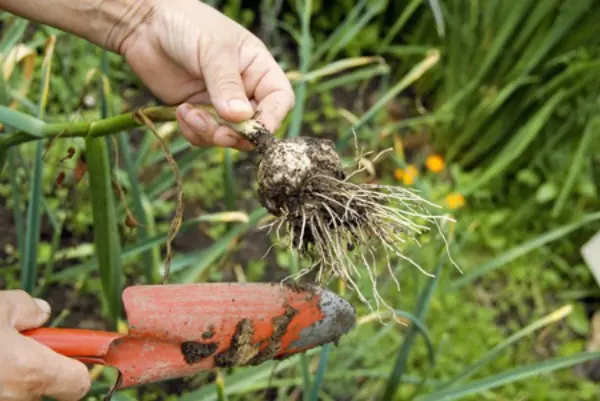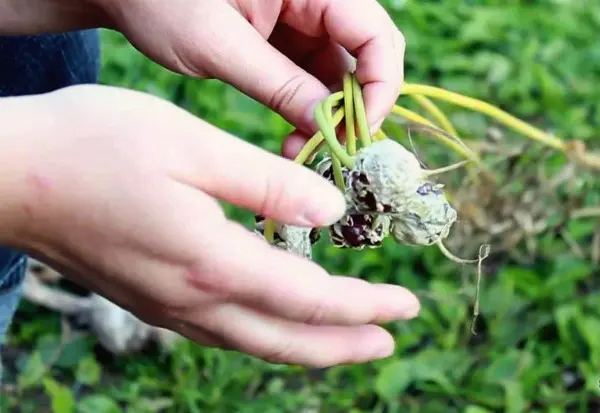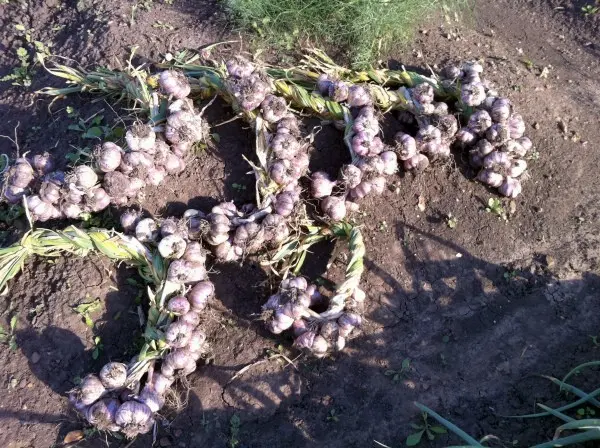Contents
For the successful storage of garlic all winter, it is very important to remove it from the garden correctly and in a timely manner. Hence the question arises: “When to remove the garlic so that it is stored as long as possible?”. In principle, there are certain dates in which the harvest should be harvested, but they can be shifted depending on the weather, the climatic conditions of the region and other factors. Therefore, experienced vegetable growers harvest garlic, focusing on external signs.
The importance of timely cleaning
As already mentioned, timely harvesting of garlic is a guarantee and guarantee of its long-term storage. If the moment was missed, it can nullify all efforts.
If you miss the deadlines for digging heads, then the following will happen to them:
- the integumentary scales will crack, which will lead to the exposure of the teeth – such bulbs quickly dry out or rot before they reach January;
- overripe bulbs can release new roots and grow again, which will negatively affect their safety;
- heads can crumble into individual teeth, which will also reduce their shelf life.

If you remove the garlic from the garden prematurely, then its immature teeth will quickly become soft. Of course, proper drying will help ripen the heads, but in this case, the garlic cloves will be slightly wrinkled.
Sometimes gardeners, afraid to miss the harvest, deliberately dig up the bulbs a week earlier and then dry them in the sun, and this does not affect its taste and storage time.
Worse, if the garlic heads are overripe, and their teeth have separated from the arrow. Such a crop cannot be saved for the winter – it needs to be processed as soon as possible or used for planting in the fall.
ripening garlic
As you know, there are two types of garlic: winter (which is planted in the fall) and spring (summer) – it is planted in the spring and dug out in the summer of the same year. Although the ripening period of a particular species is always the same, the timing of its harvest may vary depending on the region.
For example, in the middle lane, where the weather conditions are relatively stable, you can dig winter varieties in mid-July. In the northern regions, the harvest is shifted by 2, and sometimes 3 weeks. Many gardeners use the lunar calendar when harvesting, but this method is acceptable for regions with a temperate climate, but not suitable for southern or northern regions.

Residents of the Moscow region know perfectly well when to dig up garlic in the Moscow region. For a variety planted in autumn, this time falls on the last week of July and captures the first days of August. Whereas in the Leningrad region, harvesting starts a couple of weeks later, since the climate of this region is colder and more humid. In any case, you need to carefully monitor the condition of the bulbs, and then they themselves will give a signal that they are already ripe.
Signs of ripening summer garlic
Spring (summer) garlic begins to ripen in the second half of August, but depending on the weather, its collection can continue in early September. In order not to miss this important point, you need to periodically inspect the garden and the plants themselves. You can also dig out one head and inspect it. Signs that the bulbs are ready for harvesting are:
- yellowing and drying of the leaves;
- stem lodging;
- softening or drying of the root neck;
- when digging up the bulb, one can observe a hard, well-formed head with clearly defined teeth, covered with dense but dry scales.
Signs of ripening winter garlic
Garlic planted in autumn traditionally needs to be dug up 100–110 days after the first sprouts appear. As a rule, this period corresponds to the last ten days of July, but depending on the climate of the region, it can last until the beginning of August.

The winter variety differs from the summer variety in the ability to shoot arrows, at the end of which seed boxes are formed with multiple small onions. And if the culture is not planted for the purpose of obtaining seeds, then these arrows are usually broken out so that all the forces of the plant go into the formation of heads.
Experienced gardeners always leave 1-2 arrows, as they also determine the degree of ripeness of garlic.
The following signs indicate the ripening of a winter variety:
- yellowing, wilting or drying of the lower leaves – the stalks of winter garlic do not lie down;
- if arrows with bulbs are preserved, then a cracked shell is visible on them, under which small seed bulbs are exposed;
- when digging out the head, strong, almost dry scales with purple streaks are observed;
- scales are easily removed from the head;
- teeth are easily separated;
- the lower film is easily removed from the tooth.

Cleaning
As it has already become clear, timeliness in harvesting is very important, but it is equally important to be able to harvest it correctly, since there are many important points in this process:
- Dig the heads on a dry, preferably sunny day – if the weather is wet or rainy, the bulbs may rot quickly or take longer to dry.
- It is better to collect garlic in the morning so that it can dry out in the garden during the day.
- Dig the bulbs with a pitchfork or dig with a shovel so as not to damage the teeth – this way they will last longer.
- If the soil is loose and the heads are easily removed, then it is permissible to pull them out with your hands, but this must be done very carefully.
- After the garlic bulbs are taken out, the plant must be laid out in the garden until the evening to dry. Cutting the stems is not recommended for 4-6 days.
- As soon as the heads on the bed dry out, they should be carefully cleaned from the ground and transferred to a dry place for ripening.

How to store
Under a canopy or in a dry, ventilated room, garlic ripens for another 2-3 weeks. After this time, it must be prepared for storage. You should know that it is better to store garlic heads in a cool, dry place, in limbo. There are many ways to preserve a product:
- Bunches, knits, braids. For this option, the stems should not be cut, on the contrary, the longer and stronger they are, the better.
- Wicker baskets. This method allows you to store the heads until the next harvest, as good ventilation is provided in the baskets. In this case, the stems should be cut to 5-10 cm.
- Boxes, boxes. For this method of storage, the stems are cut to 2-3 cm, the heads are laid in layers and each layer is separated with parchment.
Recently, many new and original ways of preserving garlic have been invented. Knowledgeable housewives store the heads in ordinary glass jars, sprinkling them with flour, salt, or pouring sunflower oil on peeled teeth. The essence of these methods is that if you block the access of air to the product, then you can store it indefinitely.
Video “When and how to harvest garlic”
This is a helpful video about harvesting garlic: when to dig it, how to do it correctly, how to dry and store it.









